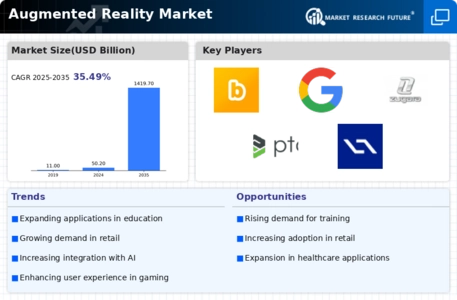-
Executive Summary
-
Scope of the Report
-
Market Definition
-
Scope of the Study
- Research Objectives
- Assumptions & Limitations
-
Markets Structure
-
Market Research Methodology
-
Research Process
-
Secondary Research
-
Primary Research
-
Forecast Model
-
Market Landscape
-
Five Forces Analysis
- Threat of New Entrants
- Bargaining power of buyers
- Threat of substitutes
- Segment rivalry
-
Value Chain/Supply Chain of Global Augmented Reality Market
-
Industry Overview of Global Augmented Reality Market
-
Introduction
-
Growth Drivers
-
Impact analysis
-
Market Challenges
-
Market Trends
-
Introduction
-
Growth Trends
-
Impact analysis
-
Global Augmented Reality Market by Component
-
Introduction
-
Hardware
- Market Estimates & Forecast, 2022-2030
- Market Estimates & Forecast by Region, 2022-2030
-
Software
- Market Estimates & Forecast, 2022-2030
- Market Estimates & Forecast by Region, 2022-2030
-
Global Augmented Reality Market by Technology
-
Introduction
-
Monitor Based Technology
- Market Estimates & Forecast, 2022-2030
- Market Estimates & Forecast by Region, 2022-2030
-
Near Eye Based Technology
- Market Estimates & Forecast, 2022-2030
- Market Estimates & Forecast by Region, 2022-2030
-
Global Augmented Reality Market by Type
-
Introduction
-
Head Mounted Display
- Market Estimates & Forecast, 2022-2030
- Market Estimates & Forecast by Region, 2022-2030
-
Head up Display
- Market Estimates & Forecast, 2022-2030
- Market Estimates & Forecast by Region, 2022-2030
-
Handheld Device
- Market Estimates & Forecast, 2022-2030
- Market Estimates & Forecast by Region, 2022-2030
-
Global Augmented Reality Market by Application
-
Introduction
-
Commercial
- Market Estimates & Forecast, 2022-2030
- Market Estimates & Forecast by Region, 2022-2030
-
Enterprise
- Market Estimates & Forecast, 2022-2030
- Market Estimates & Forecast by Region, 2022-2030
-
Medical
- Market Estimates & Forecast, 2022-2030
- Market Estimates & Forecast by Region, 2022-2030
-
Aerospace & Defense
- Market Estimates & Forecast, 2022-2030
- Market Estimates & Forecast by Region, 2022-2030
-
Energy
- Market Estimates & Forecast, 2022-2030
- Market Estimates & Forecast by Region, 2022-2030
-
Automotive
- Market Estimates & Forecast, 2022-2030
- Market Estimates & Forecast by Region, 2022-2030
-
Consumer Electronics
- Market Estimates & Forecast, 2022-2030
- Market Estimates & Forecast by Region, 2022-2030
-
Others
- Market Estimates & Forecast, 2022-2030
- Market Estimates & Forecast by Region, 2022-2030
-
Global Augmented Reality Market by Region
-
Introduction
-
North America
- Market Estimates & Forecast, 2022-2030
- Market Estimates & Forecast by Component, 2022-2030
- Market Estimates & Forecast by Technology, 2022-2030
- Market Estimates & Forecast by Type, 2022-2030
- Market Estimates & Forecast by Application, 2022-2030
- U.S.A
- Mexico
- Canada
-
Europe
- Market Estimates & Forecast, 2022-2030
- Market Estimates & Forecast by Component, 2022-2030
- Market Estimates & Forecast by Technology, 2022-2030
- Market Estimates & Forecast by Type, 2022-2030
- Market Estimates & Forecast by Application, 2022-2030
- Germany
- France
- Italy
- Spain
- UK
-
Asia Pacific
- Market Estimates & Forecast, 2022-2030
- Market Estimates & Forecast by Component, 2022-2030
- Market Estimates & Forecast by Technology, 2022-2030
- Market Estimates & Forecast by Type, 2022-2030
- Market Estimates & Forecast by Application, 2022-2030
- China
- India
- Japan
- South Korea
- Rest of Asia Pacific
-
Middle East & Africa
- Market Estimates & Forecast, 2022-2030
- Market Estimates & Forecast by Component, 2022-2030
- Market Estimates & Forecast by Technology, 2022-2030
- Market Estimates & Forecast by Type, 2022-2030
- Market Estimates & Forecast by Application, 2022-2030
-
Latin America
- Market Estimates & Forecast, 2022-2030
- Market Estimates & Forecast by Component, 2022-2030
- Market Estimates & Forecast by Technology, 2022-2030
- Market Estimates & Forecast by Type, 2022-2030
- Market Estimates & Forecast by Application, 2022-2030
-
Company Landscape
-
Company Profiles
-
Google, Inc.
- Company Overview
- Product/Business Segment Overview
- Financial Updates
- Key Developments
-
Microsoft Corporation
- Company Overview
- Product/Business Segment Overview
- Financial Updates
- Key Developments
-
PTC
- Company Overview
- Product/Business Segment Overview
- Financial Updates
- Key Developments
-
Wikitude GmbH
- Company Overview
- Product/Business Segment Overview
- Financial Updates
- Key Developments
-
DAQRI
- Company Overview
- Product/Business Segment Overview
- Financial Updates
- Key Developments
-
Zugara, Inc.
- Company Overview
- Product/Business Segment Overview
- Financial Updates
- Key Developments
-
Blippar
- Company Overview
- Product/Business Segment Overview
- Financial Updates
- Key Developments
-
Upskill
- Company Overview
- Product/Business Segment Overview
- Financial Updates
- Key Developments
-
Magic Leap
- Company Overview
- Product/Business Segment Overview
- Financial Updates
- Key Developments
-
Osterhout Design Group
- Company Overview
- Product/Business Segment Overview
- Financial Updates
- Key Developments
-
Infinity Augmented Reality, Inc.
- Company Overview
- Product/Business Segment Overview
- Financial Updates
- Key Developments
-
Samsung Electronics Co. Ltd.
- Company Overview
- Product/Business Segment Overview
- Financial Updates
- Key Developments
-
Atheer, Inc.
- Company Overview
- Product/Business Segment Overview
- Financial Updates
- Key Developments
-
Apple, Inc.
- Company Overview
- Product/Business Segment Overview
- Financial Updates
- Key Developments
-
Facebook Corporation
- Company Overview
- Product/Business Segment Overview
- Financial Updates
- Key Developments
-
Scope AR
- Company Overview
- Product/Business Segment Overview
- Financial Updates
- Key Developments
-
Inglobe Technologies
- Company Overview
- Product/Business Segment Overview
- Financial Updates
- Key Developments
-
Embitel Technologies
- Company Overview
- Product/Business Segment Overview
- Financial Updates
- Key Developments
-
Seiko Epson Corporation
- Company Overview
- Product/Business Segment Overview
- Financial Updates
- Key Developments
-
Marxent Labs LLC
- Company Overview
- Product/Business Segment Overview
- Financial Updates
- Key Developments
-
Catchoom Technologies
- Company Overview
- Product/Business Segment Overview
- Financial Updates
- Key Developments
-
HTC Corporation
- Company Overview
- Product/Business Segment Overview
- Financial Updates
- Key Developments
-
Qualcomm
- Company Overview
- Product/Business Segment Overview
- Financial Updates
- Key Developments
-
Rockwell Collins
- Company Overview
- Product/Business Segment Overview
- Financial Updates
- Key Developments
-
Conclusion
-
LIST OF TABLES
-
Global Augmented Reality Market: By Region, 2022-2030
-
North America Augmented Reality Market: By Country, 2022-2030
-
Europe Augmented Reality Market: By Country, 2022-2030
-
Asia-Pacific Augmented Reality Market: By Country, 2022-2030
-
Middle East & Africa Augmented Reality Market: By Country, 2022-2030
-
Latin America Augmented Reality Market: By Country, 2022-2030
-
Global Augmented Reality by Component Market: By Regions, 2022-2030
-
North America Augmented Reality by Component Market: By Country, 2022-2030
-
Table9 Europe Augmented Reality by Component Market: By Country, 2022-2030
-
Table10 Asia-Pacific Augmented Reality by Component Market: By Country, 2022-2030
-
Table11 Middle East & Africa Augmented Reality by Component Market: By Country, 2022-2030
-
Table12 Latin America Augmented Reality by Component Market: By Country, 2022-2030
-
Table13 Global Augmented Reality by Application Market: By Regions, 2022-2030
-
Table14 North America Augmented Reality by Application Market: By Country, 2022-2030
-
Table15 Europe Augmented Reality by Application Market: By Country, 2022-2030
-
Table16 Asia-Pacific Augmented Reality by Application Market: By Country, 2022-2030
-
Table17 Middle East & Africa Augmented Reality by Application Market: By Country, 2022-2030
-
Table18 Latin America Augmented Reality by Application Market: By Country, 2022-2030
-
Table19 North America Augmented Reality for Type Market: By Country, 2022-2030
-
Table20 Europe Augmented Reality for Type Market: By Country, 2022-2030
-
Table21 Asia-Pacific Augmented Reality for Type Market: By Country, 2022-2030
-
Table22 Middle East & Africa Augmented Reality for Type Market: By Country, 2022-2030
-
Table23 Latin America Augmented Reality for Type Market: By Country, 2022-2030
-
Table24 Global Component Market: By Region, 2022-2030
-
Table25 Global Type Market: By Region, 2022-2030
-
Table26 Global Type Market: By Region, 2022-2030
-
Table27 North America Augmented Reality Market, By Country
-
Table28 North America Augmented Reality Market, By Component
-
Table29 North America Augmented Reality Market, By Technology
-
Table30 North America Augmented Reality Market, By Type
-
Table31 North America Augmented Reality Market, By Application
-
Table32 Europe: Augmented Reality Market, By Country
-
Table33 Europe: Augmented Reality Market, By Component
-
Table34 Europe: Augmented Reality Market, By Technology
-
Table35 Europe: Augmented Reality Market, By Type
-
Europe: Augmented Reality Market, By Application
-
Table37 Asia-Pacific: Augmented Reality Market, By Country
-
Table38 Asia-Pacific: Augmented Reality Market, By Component
-
Table39 Asia-Pacific: Augmented Reality Market, By Technology
-
Table40 Asia-Pacific: Augmented Reality Market, By Type
-
Asia-Pacific: Augmented Reality Market, By Application
-
Table42 Middle East & Africa: Augmented Reality Market, By Country
-
Table43 Middle East & Africa Augmented Reality Market, By Component
-
Table44 Middle East & Africa Augmented Reality Market, By Technology
-
Table45 Middle East & Africa: Augmented Reality Market, By Type
-
Table46 Middle East & Africa: Augmented Reality Market, By Application
-
Table47 Latin America: Augmented Reality Market, By Country
-
Table48 Latin America Augmented Reality Market, By Component
-
Table49 Latin America Augmented Reality Market, By Technology
-
Table50 Latin America: Augmented Reality Market, By Type
-
Table51 Latin America: Augmented Reality Market, By Application
-
LIST OF FIGURES
-
Global Augmented Reality market segmentation
-
Forecast Methodology
-
Five Forces Analysis of Global Augmented Reality Market
-
Value Chain of Global Augmented Reality Market
-
Share of Global Augmented Reality Market in 2020, by country (in %)
-
Global Augmented Reality Market, 2022-2030,
-
Sub segments of Component
-
Global Augmented Reality Market size by Component, 2020
-
Share of Global Augmented Reality Market by Component, 2022 TO 2030
-
Global Augmented Reality Market size by Technology, 2020
-
Share of Global Augmented Reality Market by Technology, 2022 TO 2030
-
Global Augmented Reality Market size by Type, 2020
-
Share of Global Augmented Reality Market by Type, 2022 TO 2030
-
Global Augmented Reality Market size by Application, 2022 TO 2030
-
Share of Global Augmented Reality Market by Application, 2022 TO 2030
-
"









Leave a Comment